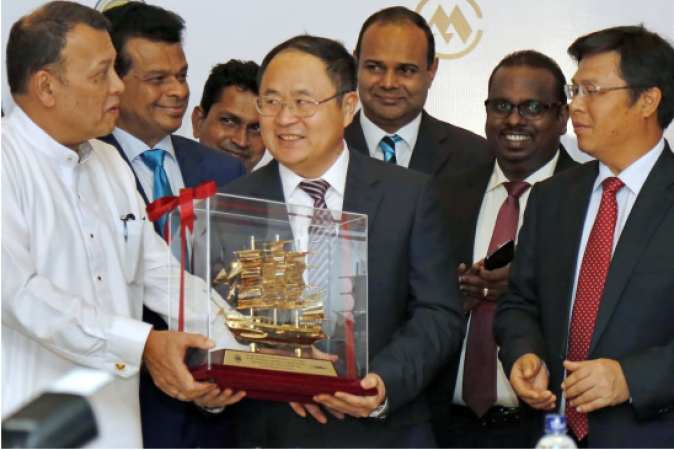
Beijing: Despite confirming that China is indeed in possession of a larger amount of Sri Lankan debt than previously thought, a US report debunks the myth of a so-called Chinese debt trap surrounding Beijing's flagship Belt and Road Initiative. proceeded to finish it.
According to the China Africa Research Initiative at the Johns Hopkins University School of Advanced International Studies, China accounted for 19.6% of Sri Lanka's US$37.6 billion external debt at the end of 2021, higher than the often quoted figure of 10-15%.
According to the report, which relied on loan agreements and data from the Sri Lankan government, the island nation's US$7.4 billion debt to China represents 52% of all bilateral debt disclosed to the World Bank.
Also Read: Can Taiwan's reopened tourism sector bring it back to life?
Sri Lanka's total debt, including central bank currency swaps, is $40.6 billion, of which 22% is owed to Chinese creditors, including a loan to China that can be repaid in its own currency after three years.
Ultimately, China also wants to pay, according to report co-author Umesh Moramudali, who also interviewed the informant and conducted archival research.
Due to record-low foreign exchange reserves, Sri Lanka was forced to declare a sovereign debt default in April as it was unable to pay for imports of essential goods such as food, fuel and medicine.
The country of 22 million people is awaiting a US$2.9 billion bailout from the International Monetary Fund (IMF), but the UN financial arm is also seeking guarantees from creditors that the loans will be restructured, including China, India and including Japan.
Also Read:IATA reports a 15% decline in air cargo volumes for Middle Eastern carriers in October
Due to Sri Lanka's reliance on foreign borrowings to fund infrastructure and consumption, the country's economic crisis had been looming for years.
The sovereign default was ultimately brought on by a string of macroeconomic missteps, including the introduction of massive tax cuts in 2019, the exhaustion of foreign reserves to maintain the value of its rupee against the US dollar, and a reduction in agricultural output due to sanctions . on fertilizers.
In 2017, Sri Lanka granted China a 99-year lease on the Hambantota International Port in exchange for US$1.1 billion, citing financial difficulties in repaying loans used to build the vital piece of infrastructure.
A key element in the development of the "Chinese debt trap" narrative, according to the report, was the lease of the loss-making Hambantota Port led by China Merchant Port, a partially state-owned company.
Moramudli continued, "[the loan agreements] clearly show that there was no asset forfeiture or loan for the equity swap."
According to the report, the leasing of the port was "identified as a potential non-debt foreign exchange inflow, which would help offset rising foreign debt repayments," as Sri Lanka grappled with balance of payments issues.
According to the report, China Merchants Port has maintained its investment in port capacity and attracted foreign investment, both of which have helped offset losses incurred by the Sri Lanka Port Authority and reduce Sri Lanka's fiscal deficit.
Foreign Ministry spokesman Wang Wenbin claimed in August, "The so-called Chinese debt trap is a lie created by the US and some other Western countries to deflect responsibility and blame."
As part of the Belt and Road Initiative, Wang claimed that China has cooperated with nearly 150 countries, spent $1 trillion and launched 3,000 projects. Beijing had also signed "cooperation documents" with 149 countries and 32 international organizations as of 4 July.
The initiative, now in its ninth year, provides Chinese support for highways, airports, ports and other infrastructure that facilitates trade in goods, often through important state-backed enterprises.
IMF Strategy Chief Sela Pazarbasioglu announced on Wednesday that she would visit China next week to discuss how to more quickly advance the debt restructuring process for countries including Sri Lanka.
Sri Lanka's debt negotiations with China "could define the future of Chinese lending not only to Sri Lanka, but also to other Belt and Road Initiative countries facing debt crunch," according to the report.
This will be the first time that a significant Asian borrower from the Belt and Road Initiative will go through the process.
This undoubtedly will not be the last Chinese debt restructuring, however, given the severe balance of payments and debt crisis that most developing countries are currently experiencing.
Also Read: TASI ends the day higher by 144 points
At the end of the previous year, approximately 35% of Sri Lanka's external debt stock was made up of foreign sovereign bonds.
The average effective interest rate on Chinese loans is 3.2%, which is lower than the 6.9% for Eurobonds but higher than that of Japan, the World Bank, and the Asian Development Bank, which ranges from 0.9 to 1.6%.
The report added that the restructuring procedure will "be a testament to how the banks work alongside one another and how Beijing coordinates the process."
In addition, the report stated that negotiations over debt restructuring with China are likely to go slowly and used the debt restructuring experiences of Suriname and Zambia as examples.
First Thilina Panduwawala, another co-author of the report, stated that China and other creditors "need to give official assent to Sri Lanka not paying the debt to them in the first place."
"We don't anticipate that the details will be decided upon in December or January," According to Panduwawala, the IMF could give Sri Lanka the US$2.9 billion if the creditors agree.
According to Panduwawala, China might offer maturity extensions and an interest rate moratorium period, but a decrease in the principal loan amount is unlikely.